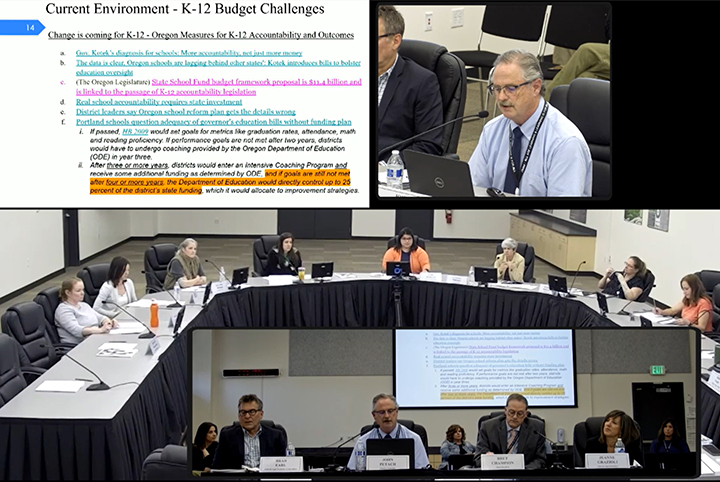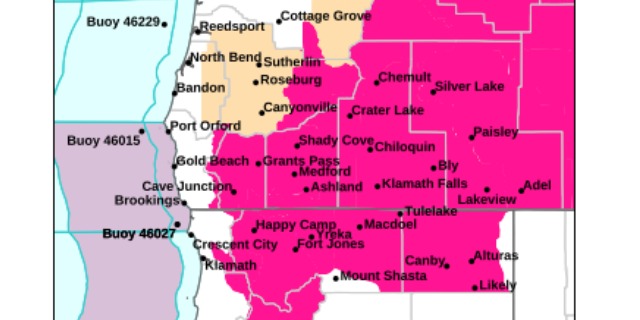Medford School District begins 2025-26 budget process with some uncertainty
Published 4:57 pm Monday, April 7, 2025
District says careful planning amid declining enrollment and unknowns in state and federal funding are crucial
While the 2025-26 Medford School District budget process will involve much discussion of state and federal funding uncertainties, ongoing enrollment declines and increased operating costs, school district officials say they’ve dealt with uncertainty before, and they’ll do so again.
The district’s budget committee convened for its first of three public meetings on Thursday to begin review of a projected $297.8 million total budget; the three-part proposed budget includes a $215.77 million general fund; $56.86 million in special revenue funds and $25.18 million in other funds.
Trending
Despite a $15 million shortfall that was predicted during the 2024-25 budget process, district officials said careful budgeting and spending down of reserves have helped reduce the overall impact.
During Thursday’s meeting, John Petach, district finance controller, spoke of waiting for the outcome of the state budget process to determine the district’s fiscal outlook.
Education, Petach said, is just one of many funding needs in the state during a time of significant need for investment in “affordable housing and homeless services, mental health and addiction programs, wildfire fighting capacity and other critical state services.”
“Legislators are rightfully wary about significant uncertainty at the federal level as we await potential changes to Medicaid funding, education funding and a host of other potential budget impacts,” Petach said.
Final decisions on state spending, including the State School Fund, are not likely to be made until after the June forecast, which comes out in late May, he said.
“Legislators and the governor are worried about seniors and babies not having health care. … They do not want to allocate any money anywhere else until they are sure what’s going to happen with Medicaid.”
Trending
Petach added, “There is a real chance school will be in session before we know what our real budget is.”
While the district is no stranger to planning for the unknown, Petach said that the coming year would likely bring longer-lasting uncertainty and potential changes “larger than ever before.”
Superintendent Bret Champion and Interim Superintendent Jeanne Grazioli, who replaces Champion July 1, spoke of positive work being done for students — by way of improved curriculum and graduation rates — and said the district was in a stronger financial position than others in the state due to early planning for expiration of COVID funding, strong financial stewardship and contingency planning.
Among concerns raised on Thursday, declining enrollment finds the district currently operating more elementary school locations than needed for the number of students enrolled. Grazioli, in her budget message, reported just three elementary schools — of 13 in the district — with enrollment above the “break-even” point of 400 students, the number required to sustain a school adequately.
With birth rates continuing to decline, consolidation to fewer locations could be inevitable, Grazioli said, in order to “maintain the variety of services and opportunities that we all value for our elementary school-age children.”
Since 2019, the district has seen a 25% decline — or 1,750 students — in elementary school enrollment, Grazioli said. For every 100 students lost, Petach said the district loses $1 million in funding.
Other ongoing challenges for the district include personnel costs — FTE positions make up 80-85% of the budget — with a $2.12 million projected increase for retirement, or PERS funding, and increased costs for special needs students.
With a state-imposed 11% cap on special education spending — a limit set 34 years ago but currently under review by the Oregon Legislature — Petach said the district spent $9 million more on special education than it was reimbursed for.
Petach said the district would also have to navigate funding impacts from Gov. Tina Kotek’s demand for increased performance from schools across the state, which could come with added state involvement under House Bill 2009.
Petach explained that the state would set goals, or metrics, for graduation rates, attendance, math and reading, and other performance areas, conducting an evaluation after two years.
“If, after three or more years, districts don’t make the goals that they’re given in any of these areas, they would enter intensive coaching — no one knows what that means — and would receive some additional funding from (Oregon Department of Education),” he said. “No one knows what that would be. … If the goals are still not met after 4 or more years, the Department of Education can directly take 25% of the school district’s budget and manage it themselves.”
Champion said the process under HB2009 was unclear and that district officials had struggled to get concrete answers on how the process would work.
A capital project requiring deficit spending of $3.3 million is included in the budget, for replacement of the South Medford High School track and field, which has been deemed unsafe for continued use.
District priorities carried over from 2024-25 included curriculum optimization; financial stability; leadership “as a keystone for staff and students;” working to improve relationships with employee organizations and the overall culture of the district; student success and safety and security, among a handful of other goals.
The proposed budget is available online.
A Q&A page is also posted with answers to questions about the fiscal stability of the district.
A video of Thursday’s meeting can be reviewed online here.
Reach reporter Buffy Pollock at 458-488-2029 or buffy.pollock@rv-times.com. Follow her on Twitter @orwritergal.









